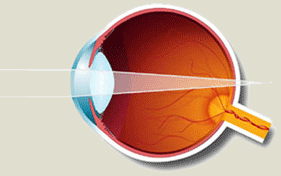Your Changing Eyes |
If you can see objects at a distance clearly but have trouble focusing well on objects close up, you may be farsighted. Your eye care practitioner may refer to farsightedness by its medical names, hypermetropia or hyperopia. Hyperopia causes the eyes to exert extra effort to see close up. After viewing nearby objects for an extended period, you may experience blurred vision, headaches and eyestrain. Children who are farsighted may find reading difficult.
Hyperopia is not a disease, nor does it mean that you have "bad eyes." It simply means that you have a variation in the shape of your eyeball. The degree of variation will determine whether or not you will need corrective lenses.

What causes farsightedness?
Hyperopia most commonly occurs because the eyeball is too short; that is, shorter from front to back than is normal. In some cases, the cornea having too little curvature may cause hyperopia. Exactly why eyeball shape varies is not known, but the tendency for farsightedness is inherited. Other factors may be involved too, but to a lesser degree than heredity.
How does farsightedness affect sight?
Our ability to "see" starts when light enters the eye through the cornea. The shape of the cornea, lens and eyeball help bend (refract) light rays in such a manner that light is focused into a point precisely on the retina. If, as in farsightedness, the eyeball is too short, the "point of light" focuses on a location behind the retina, instead of on the correct area of the retina, known as the fovea. As a result, at the point on the retina where a fine point of light should be focused, there is instead a disk-shaped area of light. Since light is not focused when it hits the retina, vision is blurred. Convex lenses are prescribed to bend light rays more sharply and bring them to focus on the retina.
Who is affected by farsightedness?
Many people have a degree of farsightedness, yet it is only a problem if it significantly affects your ability to see well or causes headaches or eyestrain.
How is it diagnosed?
Hyperopia is seldom diagnosed in school eye-screening tests, which typically test only the ability to see objects at a distance. A comprehensive eye health examination that checks both near and far vision is necessary to diagnose farsightedness.
How is it farsightedness treated?
Convex lenses — eyeglasses or contact lenses — are usually prescribed. They bend light rays more sharply and bring the rays into focus on the retina. To determine the best avenue of treatment, your eye care professional may ask a number of questions about your lifestyle, occupation, daily activities and general health status. For instance, you may be asked whether or not you frequently need near vision. Providing candid, considered answers to the questions and working with your eye care professional will help assure that your corrective lenses contribute to clear sight and general comfort.
A comprehensive eye examination at the recommended intervals will ensure that minor changes in vision are diagnosed and treated so that your vision will remain as clear and comfortable as possible.
How will hyperopia affect your lifestyle?
If glasses or contact lenses are prescribed, it may take a few days to adjust to them. After that, farsightedness probably will not significantly affect your lifestyle.
